How not to get lost on the comet Churyumov-Gerasimenko
Original article published on 2014/08/15 17:30 UTC
Rosetta nearly completed its first original triangular orbit in front of a comet. (It turns out that the apparatus’s maneuvers do not take place around the center of mass of the comet, but around the point located on its illuminated side.) Every day we get the types of nuclei from different positions. Stunning details of the relief are everywhere, but in this crazy form of the world is really difficult to navigate, so it is difficult to say whether I look at the same objects in different photos. I found out that many observers have the same problem, and decided to try to collect several images that will help us navigate the Rosetta's new home!
This attempt would be much easier if the objects on the surface had names, but of course there are no official names and names yet; Rosette has just arrived and mapping will take some time. It is tempting to give names to various terrain features, but it is somewhat presumptuous and will become completely useless when official names appear. Therefore, I will give descriptions to tell about some of the objects that interest me, and I hope in the future I will be able to give them official names.
First, let's see how the comet rotates in space. The comet consists of a large and a small fraction connected by a narrow isthmus. The axis of rotation of the comet is located at the point where a large proportion is connected to the isthmus. The coordinate system for the comet is already indicated, with the north and south poles at the points where the axis of rotation exits the nucleus. A large share - the zero meridian, and a small share - the 180th. Let's see how the coordinate grid falls on the comet surface on this animation:
')
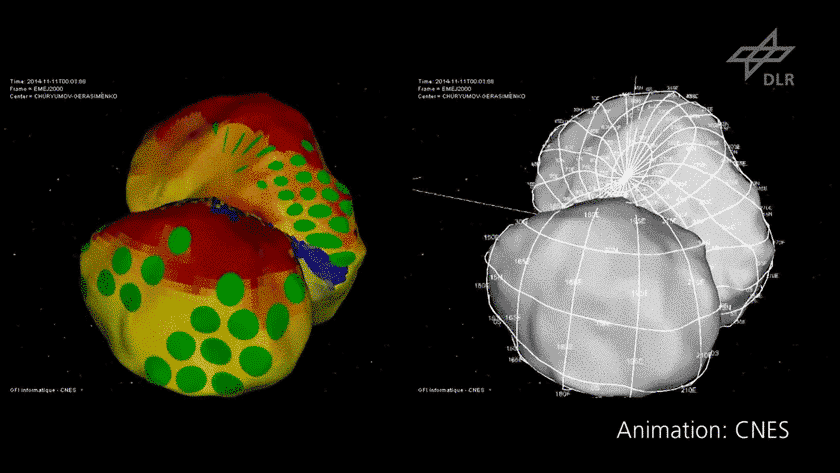
ESA / Rosetta / DLR / MPS for OSIRIS Team MPS / UPD / LAM / IAA / SSO / INTA / UPM / DASP / IDA
Geography and sunlight on comet Churyumov-Gerasimenko
So, if we look at the left part of the animation, we will see a color image of the comet. For now, let's not pay attention to green spots; look at the red and yellow areas. These colors indicate how often different areas of the comet are illuminated by the sun. Red areas are almost always lit. You can see that there are two poles of eternal light, one for each of the beams. If some part is always lit, then there are areas that are constantly in the shade. Most of the comet above 30 degrees north latitude is always illuminated. Therefore, we do not see that part of the comet that is below 30 degrees south latitude.
From the animation it becomes clear that if you take any photo of the comet and arrange it so that the light would go as if from above, then the north will also be from above. The only time this doesn’t work is when Rosetta shoots the north pole itself.
Of course, looking at the latest pictures with NavCam, I realized that most of them are looking at the pole. Here are all the photos taken by NavCam during the first round. The top row is a pole shot, so I placed them so that a small fraction (180 degrees longitude) was at the top. The bottom row was made at a slight angle, so I positioned them so that the north was approximately on top. (Not sure which row to put the top-right photo.)
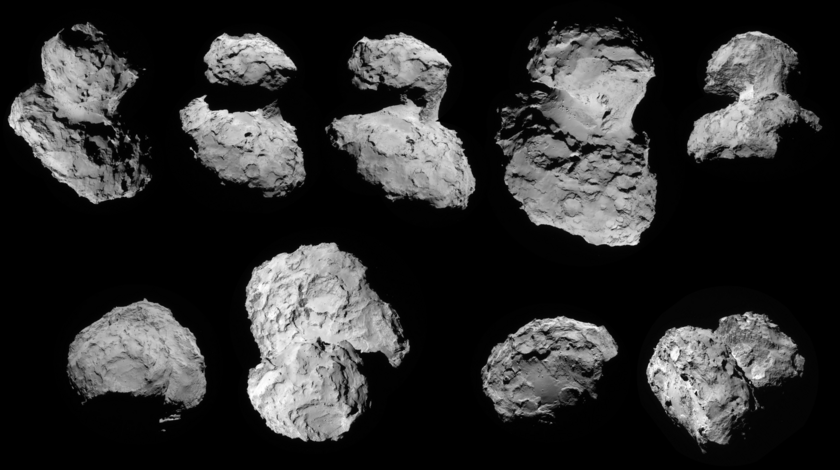
ESA / Rosetta / NavCam / Emily Lakdawalla
NavCam images of comet Churyumov-Gerasimenko from Rosetta's first orbit
Now we are a little oriented and can take yesterday's image from the OSIRIS camera. In fact, this is a pair of images, left and right stereo pair. This is the first image of a comet that takes up the entire overview of the OSIRIS camera. OSIRIS has the largest detector outside the Earth at the moment: it is a 4 megapixel camera, each image with a side of 2048 pixels. Take your red and blue glasses and enjoy the 3D view, or just look at the left or right image separately.

ESA / Rosetta / DLR / MPS for OSIRIS Team MPS / UPD / LAM / IAA / SSO / INTA / UPM / DASP / IDA
Churyumov-Gerasimenko in 3D, August 7, 2014
What are we looking at? We are looking through a large share towards a small share. The north pole is tilted slightly to the left.
I see three completely different types of terrain. The first is a very, very smooth surface. In my opinion, it looks like a robe that hides something under it. In one place, I noticed something similar to the impact crater on it. I think that there were other impact craters, the edges of which are smeared or destroyed.

In some places there are fields of cobblestones. There is one particularly noticeable field on the isthmus. I have already said that I will give only descriptions, but it seems I will never get rid of the idea that this chain of cobblestones looks like a necklace.
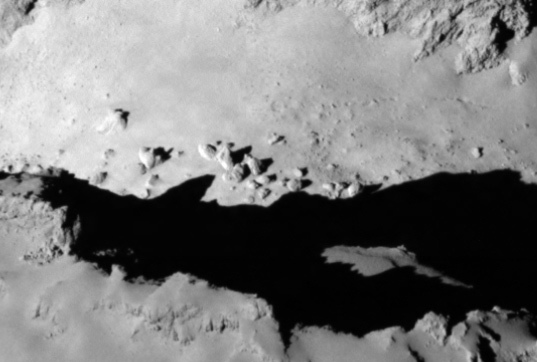
On some images with NavCam, you can also see a group of strange vertical furrows. In some places they look as if they are on the smooth surface of the isthmus; in other places they seem to be slightly covered with it, bulging out of it.
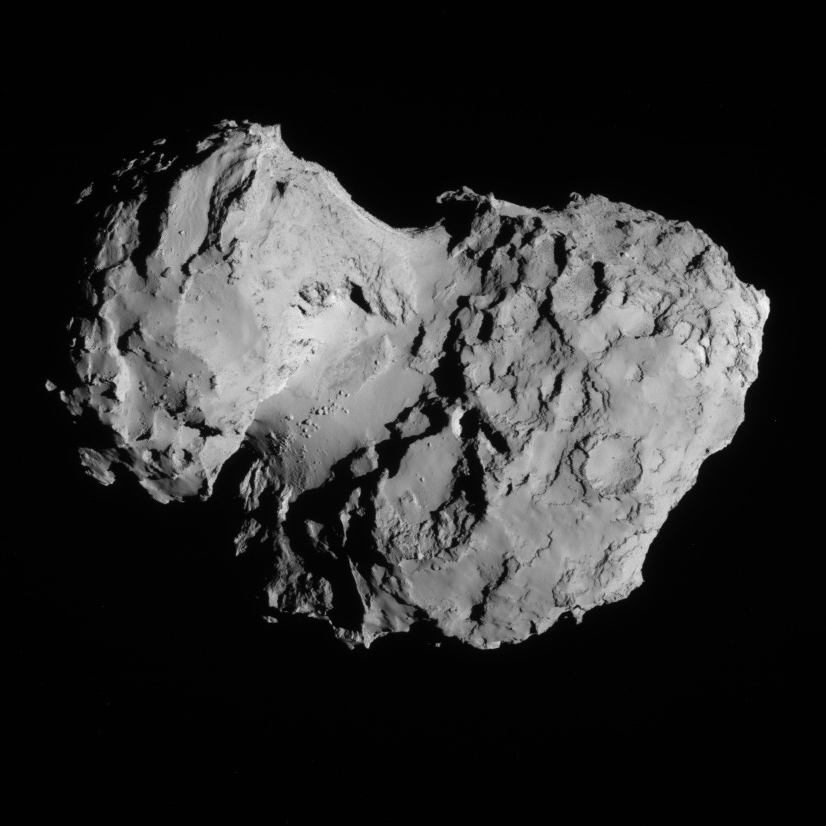
But the surface that really attracts attention is a place on the wall of a small fraction that looks towards the isthmus. It is striped or ribbon. I would not say that it is layered. This is a pronounced surface with folds, small ridges and depressions. Perhaps several intersecting surfaces. You can see transverse folds on steep slopes that start from a smoother surface and to a pole of light on a small fraction. This surface consists of a fairly coherent material, which creates impressive silhouettes against the background of black space.
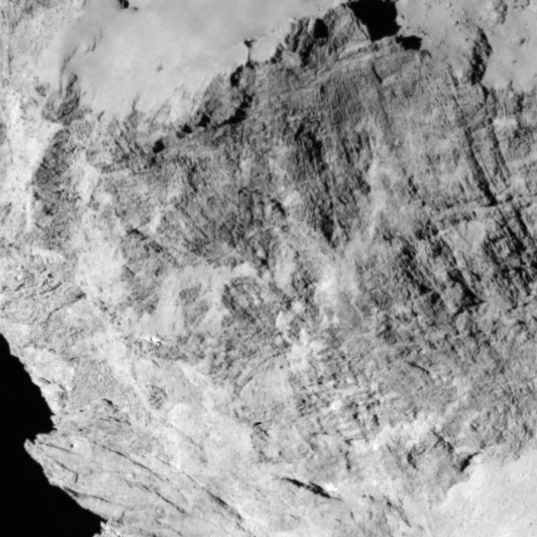
Here is a more general view with NavCam.
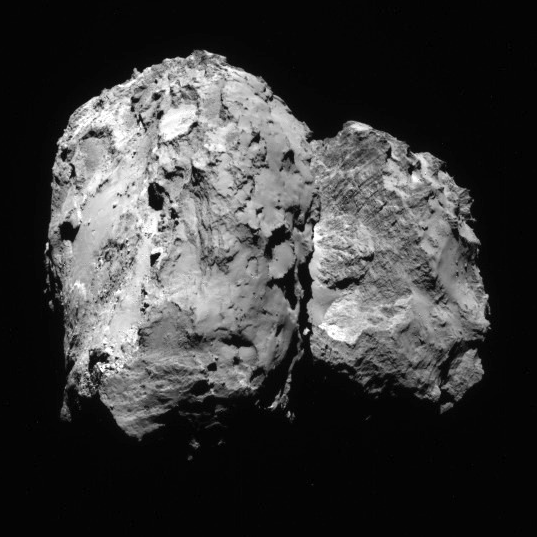
In other places, the comet is also replete with objects with high round edges. Surprisingly round. It's hard for me to imagine how you can make such high round edges, unless it is impact craters.
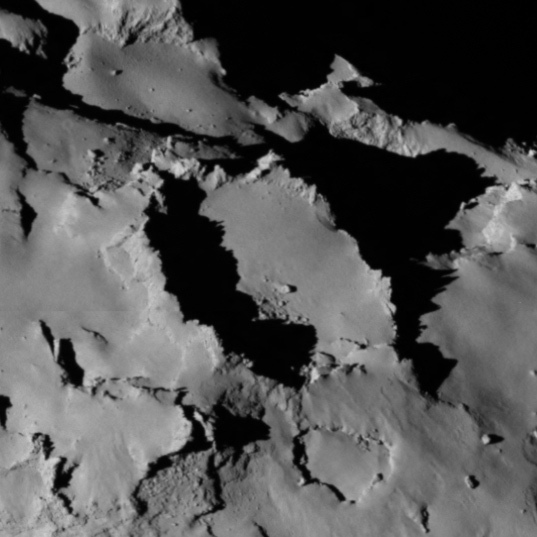
But if these are impact craters, then a lot has happened to them since they formed. See what an interesting object at the top of the ridge.
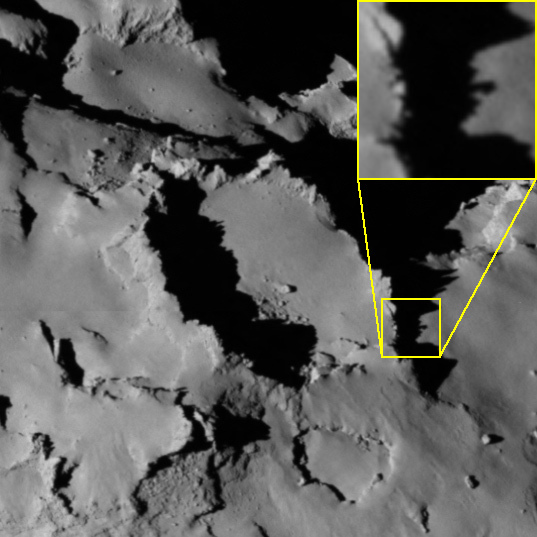
Starting from Sunday, Rosetta will move to a slightly lower orbit, about 80 km, and the rest of August will conduct observations from this altitude. Stay in touch!
PS Transferred to the Cosmonautics hub. Thanks to all!
PPS I will be glad to error messages in PM.
Rosetta nearly completed its first original triangular orbit in front of a comet. (It turns out that the apparatus’s maneuvers do not take place around the center of mass of the comet, but around the point located on its illuminated side.) Every day we get the types of nuclei from different positions. Stunning details of the relief are everywhere, but in this crazy form of the world is really difficult to navigate, so it is difficult to say whether I look at the same objects in different photos. I found out that many observers have the same problem, and decided to try to collect several images that will help us navigate the Rosetta's new home!
This attempt would be much easier if the objects on the surface had names, but of course there are no official names and names yet; Rosette has just arrived and mapping will take some time. It is tempting to give names to various terrain features, but it is somewhat presumptuous and will become completely useless when official names appear. Therefore, I will give descriptions to tell about some of the objects that interest me, and I hope in the future I will be able to give them official names.
First, let's see how the comet rotates in space. The comet consists of a large and a small fraction connected by a narrow isthmus. The axis of rotation of the comet is located at the point where a large proportion is connected to the isthmus. The coordinate system for the comet is already indicated, with the north and south poles at the points where the axis of rotation exits the nucleus. A large share - the zero meridian, and a small share - the 180th. Let's see how the coordinate grid falls on the comet surface on this animation:
')

ESA / Rosetta / DLR / MPS for OSIRIS Team MPS / UPD / LAM / IAA / SSO / INTA / UPM / DASP / IDA
Geography and sunlight on comet Churyumov-Gerasimenko
So, if we look at the left part of the animation, we will see a color image of the comet. For now, let's not pay attention to green spots; look at the red and yellow areas. These colors indicate how often different areas of the comet are illuminated by the sun. Red areas are almost always lit. You can see that there are two poles of eternal light, one for each of the beams. If some part is always lit, then there are areas that are constantly in the shade. Most of the comet above 30 degrees north latitude is always illuminated. Therefore, we do not see that part of the comet that is below 30 degrees south latitude.
From the animation it becomes clear that if you take any photo of the comet and arrange it so that the light would go as if from above, then the north will also be from above. The only time this doesn’t work is when Rosetta shoots the north pole itself.
Of course, looking at the latest pictures with NavCam, I realized that most of them are looking at the pole. Here are all the photos taken by NavCam during the first round. The top row is a pole shot, so I placed them so that a small fraction (180 degrees longitude) was at the top. The bottom row was made at a slight angle, so I positioned them so that the north was approximately on top. (Not sure which row to put the top-right photo.)

ESA / Rosetta / NavCam / Emily Lakdawalla
NavCam images of comet Churyumov-Gerasimenko from Rosetta's first orbit
Now we are a little oriented and can take yesterday's image from the OSIRIS camera. In fact, this is a pair of images, left and right stereo pair. This is the first image of a comet that takes up the entire overview of the OSIRIS camera. OSIRIS has the largest detector outside the Earth at the moment: it is a 4 megapixel camera, each image with a side of 2048 pixels. Take your red and blue glasses and enjoy the 3D view, or just look at the left or right image separately.

ESA / Rosetta / DLR / MPS for OSIRIS Team MPS / UPD / LAM / IAA / SSO / INTA / UPM / DASP / IDA
Churyumov-Gerasimenko in 3D, August 7, 2014
What are we looking at? We are looking through a large share towards a small share. The north pole is tilted slightly to the left.
I see three completely different types of terrain. The first is a very, very smooth surface. In my opinion, it looks like a robe that hides something under it. In one place, I noticed something similar to the impact crater on it. I think that there were other impact craters, the edges of which are smeared or destroyed.

In some places there are fields of cobblestones. There is one particularly noticeable field on the isthmus. I have already said that I will give only descriptions, but it seems I will never get rid of the idea that this chain of cobblestones looks like a necklace.

On some images with NavCam, you can also see a group of strange vertical furrows. In some places they look as if they are on the smooth surface of the isthmus; in other places they seem to be slightly covered with it, bulging out of it.

But the surface that really attracts attention is a place on the wall of a small fraction that looks towards the isthmus. It is striped or ribbon. I would not say that it is layered. This is a pronounced surface with folds, small ridges and depressions. Perhaps several intersecting surfaces. You can see transverse folds on steep slopes that start from a smoother surface and to a pole of light on a small fraction. This surface consists of a fairly coherent material, which creates impressive silhouettes against the background of black space.

Here is a more general view with NavCam.

In other places, the comet is also replete with objects with high round edges. Surprisingly round. It's hard for me to imagine how you can make such high round edges, unless it is impact craters.

But if these are impact craters, then a lot has happened to them since they formed. See what an interesting object at the top of the ridge.

Starting from Sunday, Rosetta will move to a slightly lower orbit, about 80 km, and the rest of August will conduct observations from this altitude. Stay in touch!
PS Transferred to the Cosmonautics hub. Thanks to all!
PPS I will be glad to error messages in PM.
Source: https://habr.com/ru/post/233975/
All Articles